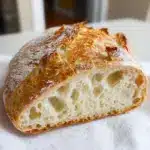Artisan Bread Recipe
This artisan bread recipe produces a crusty, golden loaf with a soft, chewy interior. Using simple ingredients and a long fermentation process, it delivers bakery-quality bread at home with minimal effort. Perfect for sandwiches, toast, or enjoying plain with butter.
- Prep Time: 10 minutes
- Cook Time: 30 minutes
- Total Time: 2 hours 40 minutes to 10 hours 40 minutes (including rising time)
- Yield: 1 large loaf or 2 smaller loaves 1x
- Category: Bread
- Method: Baking
- Cuisine: American/European Artisan
- Diet: Vegetarian
Ingredients
Scale
Dry Ingredients
- 3 cups (395 grams) all-purpose flour or bread flour
- ½ tablespoon kosher salt
- ¼ ounce instant or active dry yeast packet (or 2 ¼ teaspoons)
Wet Ingredients
- 1 ½ cups warm water (105°F)
Instructions
- Combine Ingredients: In a large bowl, mix the flour, kosher salt, and yeast until evenly distributed.
- Add Water and Mix: Pour the warm water over the dry ingredients and stir until the dough forms a sticky but manageable mass.
- First Rise: Cover the bowl with a towel or plastic wrap and let the dough rise at room temperature for 2 to 10 hours, or preferably overnight, to develop flavor.
- Shape the Loaf: Wet your hands to prevent sticking, turn the dough onto a lightly floured surface, and gently fold the edges into the center to create a round loaf. Alternatively, divide into two smaller loaves by tucking the ends underneath.
- Rest the Dough: Transfer the shaped dough onto parchment paper, dust the top with flour, and score 1 to 4 lines on the surface with a bread knife. Let it rest for 20 to 30 minutes.
- Preheat Oven: Heat your oven to 450°F (232°C) with a baking stone, pizza stone, Dutch oven, or iron skillet inside to create a hot baking surface.
- Prepare for Baking: Slide the dough on the parchment paper onto the preheated surface. For a crustier bread, add 1 cup hot water or 5 ice cubes to the oven bottom to generate steam, then quickly close the oven door.
- Bake: Bake the bread for 25 to 30 minutes until the crust turns golden brown and crispy.
- Cool: Remove the bread and allow it to cool on a wire rack for at least 30 minutes before slicing to set the crumb structure.
- Storage: Store the cooled bread in a paper bag to maintain the crust’s crispness while preventing it from drying out.
Notes
- Using bread flour will result in a chewier texture due to higher protein content.
- A longer rise time develops a better flavor and texture, so overnight rising is recommended if possible.
- Scoring the dough controls expansion and creates an attractive crust pattern.
- Creating steam in the oven helps form a crunchy crust by keeping the surface moist during the initial baking phase.
- Letting the bread cool completely prevents a gummy texture inside.
- Store the bread in a paper bag rather than plastic to keep the crust crisp while avoiding moisture buildup.
Nutrition
- Serving Size: 1 slice (about 56 grams)
- Calories: 150
- Sugar: 0.2 grams
- Sodium: 230 milligrams
- Fat: 1 gram
- Saturated Fat: 0.2 grams
- Unsaturated Fat: 0.6 grams
- Trans Fat: 0 grams
- Carbohydrates: 31 grams
- Fiber: 1.5 grams
- Protein: 5 grams
- Cholesterol: 0 milligrams
Keywords: artisan bread, homemade bread, crusty bread, simple bread recipe, no-knead bread
Find it online: https://lucabites.com/artisan-bread-recipe-2/

